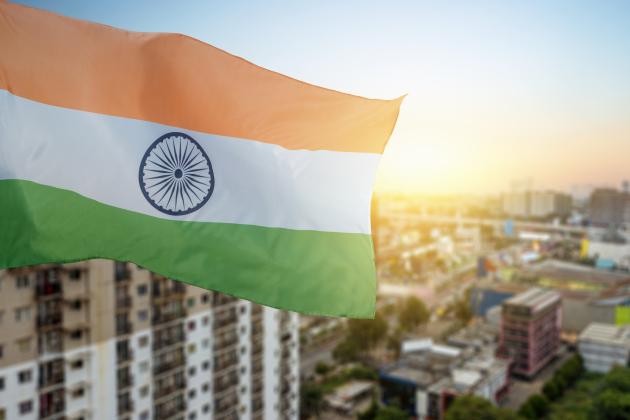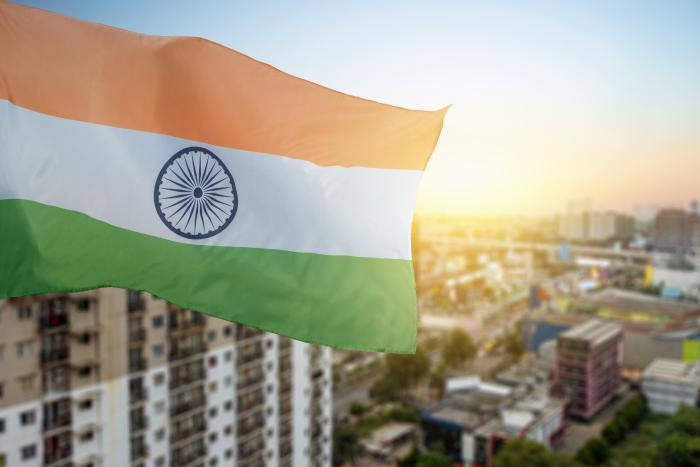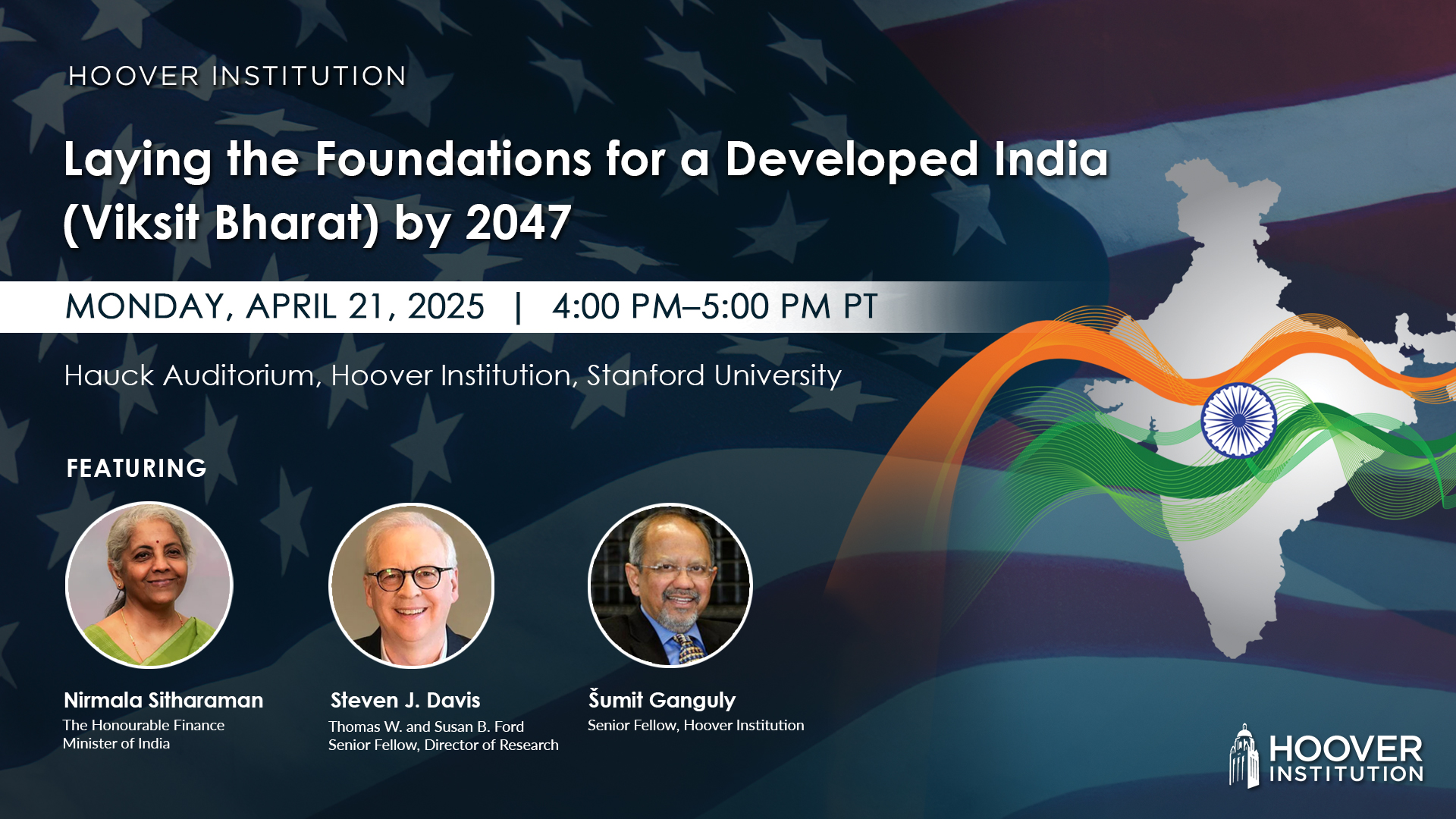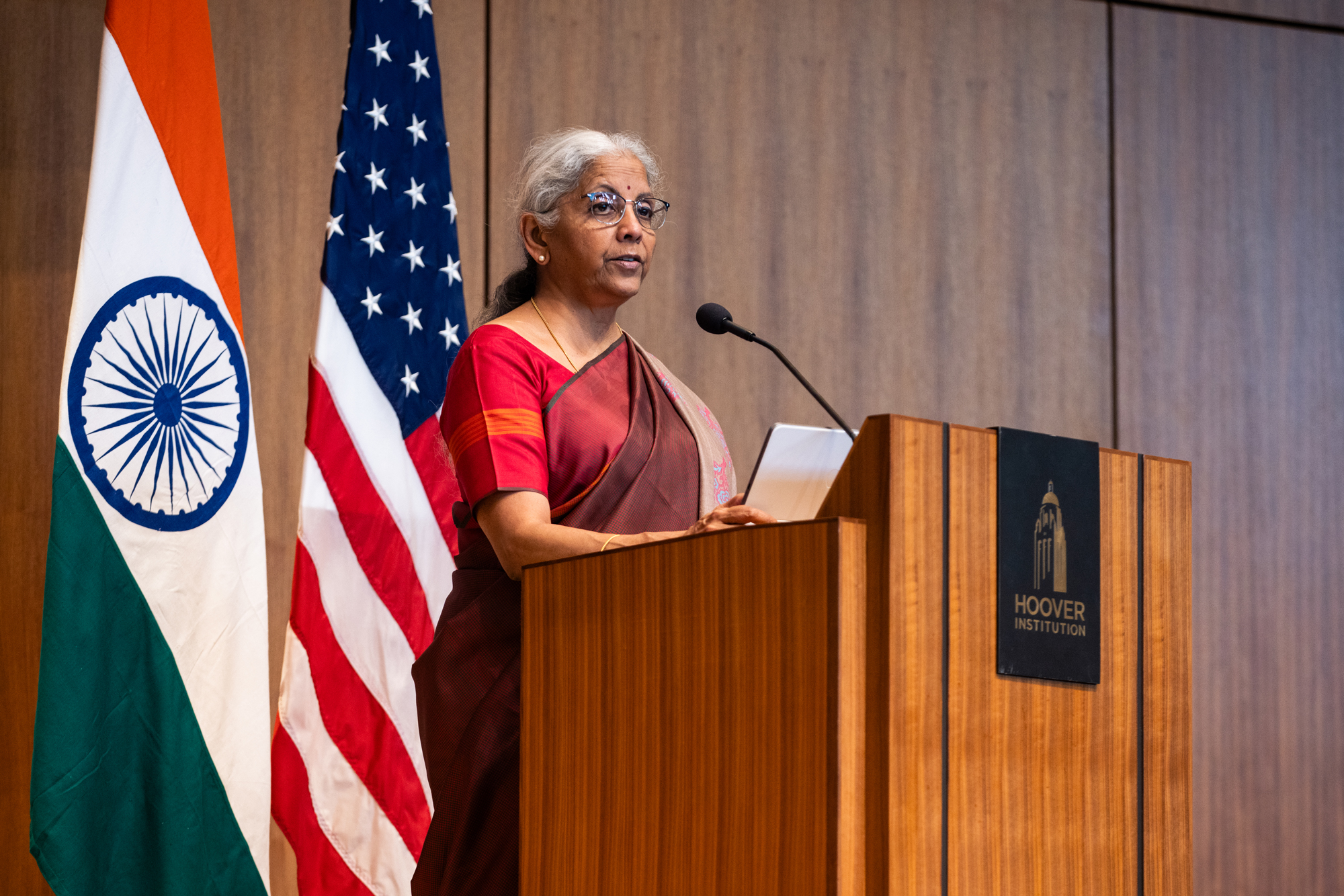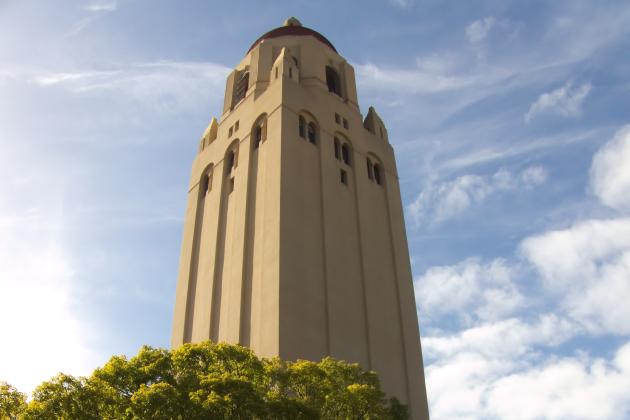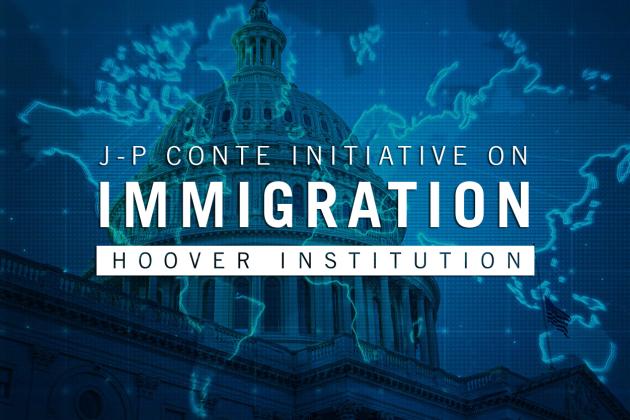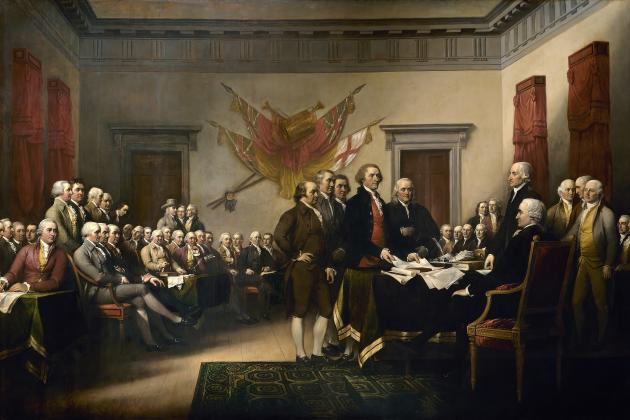The Hoover Institution hosted, "Laying the Foundations for a Developed India (Viksit Bharat) by 2047," on Monday, April 21, 2025, at 4:00 pm PT in Hauck Auditorium, Hoover Institution. The event will feature a keynote address and fireside chat with Nirmala Sitharaman, the Honourable Finance Minister of India.
WATCH THE VIDEO
>> Sumit Ganguly: Thank you everyone for coming on this stunning California afternoon. I am Sumit Ganguly, and I direct the Huntington Program on Strengthening US-India Relations here at the Hoover Institution at Stanford University. And it is my particular pleasure this afternoon to host the Minister for Finance and Corporate Affairs, Nirmala Sitharaman from India.
And at the outset, it is necessary on my part to remind all of you to please put your cell phones on silent mode. The last thing we need is a cell phone going off with a popular Bollywood tune.
>> Sumit Ganguly: In the middle of the Minister's speech. So without any further ado, let me turn the podium over to Minister Sitharaman who will speak on the prospect of a developed India by 2047.
But before I do so, a brief word of introduction. Minister Sitharaman has advanced degrees in economics from India's premier social science university, Jawaharlal Nehru University. She has previously been the Minister of Defense and is currently the Minister for Finance and Corporate Affairs. Her entire resume would essentially fill up a Senate filibuster.
And so I will refrain from that temptation to read out her entire CV and instead just give you these pertinent details. So without any further ado, Minister Sitharaman, the podium is yours.
>> Nirmala Sitharaman: Thank you, good afternoon, and what a pleasure and what an honor it is for me to stand before you in this lovely, sunny, nice auditorium.
And it's also a pleasant day here in San Francisco. I didn't expect it to be so bright. Delhi is hot and we have the Vice President with his family also in Delhi has had a meeting with the Prime Minister. I'm here to talk to you on laying the foundation for developed India that is Viksit Bharat by 2047.
So I'll make a formal address post, which I understand a professor would hold an interaction interactive session with you. I look forward to that. So indulge me with this formal address that I like to do on the topic. India's journey to become a Viksit Bharat by 2047 is not merely an aspiration, but a shared national mission powered by a vision for inclusive, sustainable, and innovation-led growth.
Despite the pandemic shock and a banking crisis, our progress over the past decade, anchored in strong macroeconomic fundamentals and steady reforms, gives us the confidence and direction for the road ahead. As a result, India has risen from the world's 10th largest economy to the fifth largest in just five years, a clear sign of our growing strength and global relevance.
However, for several countries, the impact of the pandemic on their growth and growth prospects lingers even as the domestic growth suffers further shocks from unprecedented external competition. Naturally, there has been a threefold increase in new trade restrictions since 2019 as countries, advanced and emerging, strive to protect domestic production and jobs.
Unsurprisingly, global trade and investment landscapes are being reimagined to bring about better balance between externally-led growth and domestic growth. Between Main Street and the Wall Street, and between energy transition and energy security. India relates to these developments. At first glance, these developments appear formidable and yet they are full of possibility.
New opportunities for deeper participation present themselves. The United States and India have enjoyed a long-standing economic collaboration which can be strengthened to enable industry participation and partnership and investments in several key sectors. Semiconductors, nuclear power generation, quantum computing, and pharmaceuticals come to my mind as frontier areas of collaboration domestically over the next two decades.
Sustaining India's growth momentum calls for a fresh approach grounded in bold reforms, stronger domestic capacities, renewed institutional partnership and adaptive strategies suited for the evolving global landscape. The last two union budgets have laid the groundwork for this transformation with a clear multisectoral policy agenda. Manufacturing is a force multiplier for the services sector growth and not so much the other way around.
Manufacturing binds societies and leads and lends cohesion to communities by providing employment opportunities and financial strength to communities. In the post-COVID world, manufacturing enhances national security also. In India, too, as we strengthen our foundations for long-term growth, manufacturing emerges as a key engine for transformation. Manufacturing has historically been a cornerstone of the economic transformation of nations from 19th century Britain to 21st century East Asia.
It creates a forward and backward linkages, catalyzes skilling, and pushes demand for infrastructure and governance reforms. For India, scaling up manufacturing is essential to absorb a youthful workforce, reduce import dependencies, and build competitive global supply. Chains. Physical infrastructure enables manufacturing to grow by putting markets, both local and global within the reach.
Over the past decade, a significant thrust on infrastructure development has also created a strong foundation for manufacturing led growth by bolstering investor confidence. This has been enabled by a more than four fold increase in the Union government's capital expenditure between 2017-18 and 25-26 budget. Expanding the national highways network, building airports, better rail connectivity and a sharp reduction in port turnaround times have all contributed to a more efficient logistics network.
As a result, India's ranking in the World Bank's Logistic Performance index has improved from 54 in 2014 to 38 in 2023. Second, a vibrant and thriving network of small and medium enterprises is essential for domestic manufacturing to grow. Our government has undertaken numerous initiatives to support the MSMEs from easing access to credit, redefining size thresholds.
Facilitating prompt payment from large buyers and simplifying compliance burdens. The Open Network for Digital Commerce, launched in April 2022 has successfully onboarded more than 764,000 vendors across 616 cities in India. 616 cities in India our next focus is reducing regulatory frictions, digitizing approvals and integrating MSMEs into global value chains.
Special support to women led and rural enterprises will help enhance economic opportunities and ensure more inclusive growth. Startups and innovation form the cornerstone of the India US relationship. On the one hand, India is a leading exporter of startup acumen to the us. For instance, a report by India, SPORA and BCG shows that Indian first generation immigrants founded 72 unicorns between 2018 and 2023.
These unicorns were worth at least US$195 billion in valuation and employed 55,000 people, nearly 55,000 people. On the other hand, the US has been foundational to India's startup growth journey. Not only is the US a large investor in Indian startups, but it has also helped co create the Global Capability center as a landscape in India.
More than 65% of the GCCs in India have their headquarters in the United States. These GCCs provide high value added bespoke services in areas such as R and D, management consulting and auditing. While the US is a mature startup hub which has developed over 50 to 60 years, India's startup journey is a nascent one.
Over the course of last decade, the government's focus was on reducing the cost of entrepreneurial risk taking by removing regulatory and infrastructural barriers. For instance, around 57 regulations have been simplified for startups. As a result, India now ranks second globally in innovation quality among middle income economies with top rankings in the quality of scientific publications and universities.
Since the Startup India initiative of 2016, stability in the startup system has been enhanced through over 50 reforms in areas related to raising capital. Ease of doing business, a host of tax benefits, reducing compliances, relaxing credit repayment policies and intellectual property rights. Fast tracking of the IPR process, the fund of funds and the creating and the credit guarantee scheme for startups support seed funding and successive credit needs.
In the recent budget 2425, angel tax for startups was done away with to reduce costs for the startups. Government also provides an R and D platform for high tech sectors through schemes such as ATAL Innovation Mission, Metis, Startup Hub. The scheme for technology incubation and development of entrepreneurs called Tide 2.0among various others.
Entrepreneurs are assisted in marketing and networking with corporate entities, industry associations, government departments and even public sector undertakings. Budget 2425 sorry, Budget 2425 explicitly states innovation, research and development as an area of priority. While charting the roadmap to Vikasid Bharat, the Budget also sought to operationalize the Anusandhan National Research Fund for Prototype design developments.
Further, a financing pool of one trillion rupees was allocated for intensivizing private sector research. Successfully scaling up businesses calls for skilled workforce with nearly 65% of its population under 35, India has an unprecedented opportunity to reap a demographic dividend. But this requires matching education and skilling with demands of Industry 4.0 India aims to educate and empower a generation that will not only work in new industries, but also lead them.
The National Education Policy 2020 is a step in this direction. Its focus on experimental learning, digital fluency and interdisciplinary thinking lays a strong foundation. Equitable access to modern infrastructure, faculty training and industry aligned curricula will determine outcomes in rural and unserved areas. Digital learning and modernized classrooms are becoming a reality not an aspiration anymore.
Importantly, our skilling agenda is inclusive. We encourage greater participation of women in the workforce and are committed to eliminating the hurdles to women's employment. Ensuring workplace safety, equal opportunity and access to finance for women entrepreneurs will enrich the workforce, strengthen social equality and so on. Prudent fiscal management will be one of the most important pillars of India's drive towards Vikasit Bharat in the medium to long run.
We are keen to manage our fiscal policy in such a way as to strike a comfortable saving investment balance and a strong external account position while also leaving adequate scope for our private sector enterprises to mobilize the required investable resources at reasonable cost. As evidenced by our fiscal track record since COVID we have been focused on fiscal consolidation.
In 202021 we promised to more than halve the fiscal deficit. We have delivered on that promise as the federal government's deficit ratio has declined from 9.2% of the GDP to a budgeted 4.4% of GDP this financial year. The high quality of fiscal consolidation is reflected in the increased share of capital expenditure over the years.
Alongside the reduction in debt and deficit. The government's capital expenditure as percentage of GDP increased from 2.1% to 3.1% in 202526 compared to 202021 when it was 2.1%. We have also announced a glide path to medium term consolidation. We see government as an enabler. Unleashing the productive forces I have mentioned so far requires broad based deregulation and an emphasis on trust based governance.
Over the last decade we have undertaken structural reforms rationalizing over 20,000 compliances, decriminalizing business laws and digitizing public services to reduce friction. Our experience with implementing the Business Reform Action Plan by different elected state governments has demonstrated that deregulation is a powerful catalyst for industrial growth. We remain committed to further simplifying regulation and processes to reduce business costs, particularly for MSMEs and enhance productivity.
Flexible labor laws, transparent land markets and simplified tax regimes must converge to create a seamless competitive environment. Achieving this vision will require sustained collaboration between the center and the state governments. To conclude, as we lay the foundation for a developed India, we must stay committed to long term goals without losing sight of present realities.
The global order is changing that poses challenges but also opportunities. We must be prepared to tackle the former while seizing the latter. Domestically, growth, jobs, sustainability and inclusion are not competing goals. They are interdependent objectives that must be pursued harmoniously. A Vikasit Bharat will be shaped not only by the government but by the collective effort of every citizen.
This vision calls upon us to think boldly, act inclusively, and stay resilient and flexible. Thank you.
>> Sumit Ganguly: It is my pleasure now to introduce Professor Stephen Davis, the Thomas W. And Susan B. Ford Senior Fellow and Director of Research at the Hoover Institution. We have heard a splendid an insightful speech from the Finance Minister.
Now my colleague, Professor Davis will engage in a fireside chat with the finance Minister and dwell on several of the issues that she highlighted in her insightful speech. Thank you. Stephen, the floor is yours.
>> Steven J. Davis: Thank you, Shumit. And thank you, Minister, for joining us today, for sharing your observations and giving us a chance to talk.
We and I personally are delighted to welcome you here to Hoover and to Stanford. So thank you very much. You laid out a vision for India's economic development path in the coming decades. There were many elements to it. Some were music to an economist's ear, like deregulation, trying to simplify processes for business investment and skills and so on.
You put a lot of stress on the manufacturing sector and its development for India. I wanted to ask you about what looked to me like some challenges that India will face in see how you plan to respond to them. And one, I'm a bit sad to say, emanates from the direction of US Trade policy under the second Trump administration.
You are well aware of this, I believe. Vice President Vance and Prime Minister Modi met earlier today for, among other things, trade talks. You are meeting U.S. treasury Secretary Scott Besant later this week. I'm going to venture a guess that trade policy will be on the agenda. So the challenge here, which I think many already are well aware of, is that in the last few weeks, the Trump administration has dramatically hiked U.S. tariff rates on imports from other countries, including India.
I think India's tariff rates are currently now at 10%. There's threats to raise them to 26%. It looks like there could be a major change in the global trading system that makes it harder to generate an export led growth process through manufacturing or otherwise. And as I sit here, as an American, as an economist, I wonder what it looks like from your vantage point as an Indian finance minister.
So tell me what it looks like and how you think India can navigate this challenge.
>> Nirmala Sitharaman: Session. I think it gives me an opportunity to explain quite a few things that Prime Minister Modi is planning for his third term. I derive my first message for the question that you asked as my reply.
First message is when you have stability in government, when you have consistency in policy, a predictability in tax regime, investments and growth can be planned and executed to a large extent. But even with this kind of a global uncertainty, I would think that is primarily the reason why India continues to be the fastest growing economy.
It is that stability which people of India voted for, which I think is the biggest strength with which today we were one of the earliest to approach the new administration in the United States to talk trade, to start the negotiation as it were, for a trade deal. And if anything, India's biggest and the topmost trading partner is United States of America.
And that importance is not lost on today's government in India. Prime Minister visited United States in February this year. Commerce Minister visited United States. The Foreign Minister had come and although the context is world World bank and IMF spring meetings, I'm here to meet my counterpart as well.
So the importance that the United States has for India's trade relationship cannot be more emphasized upon within the first three months of the new administration. These are the visits which have happened and the negotiations have commenced. Equally, I appreciate the US Administration in sending the additional USTR to India to start or to continue the negotiation process.
So a message that we are on probably a very productive and engaging face is well-established and if anything, the first tranche of the trade agreement I hope will be concluded by the fall this year. So we've been open minded and very clearly stating the importance of this trade relationship between India and the US.
>> Steven J. Davis: Okay, so you're-
>> Steven J. Davis: That was a well received answer. So you're hopeful?
>> Nirmala Sitharaman: I'm very hopeful.
>> Steven J. Davis: Very hopeful. Okay, well I appreciate that. I will try to absorb some of that as I look at the conduct of my own government. Let me turn to a different type of challenge that it seems to me India will face in, in the manufacturing led growth part of what you talked about, especially on the job side.
So if you look across really all the major economies of the world, we'll come back to China in a second. But the share of manufacturing jobs as a share of all jobs has been on a declining trend in the richer countries like the United States. It's been on a declining trend for half a century in less developed economies.
Maybe it's only the last 20 or 30 years. The data for China are murky on this as many much data are for China. But as near as I can tell the story in China over the last 20 years is, and that's the manufacturing powerhouse of the world. The share of employment in the manufacturing sector is flat or declining slowly.
And we think we know why this is as economists and there's two basic reasons, there's tremendous labor saving, technology growth, and capital deepening in the manufacturing sector. And there's a general pattern that as economies get richer, you only need so many shoes. You start to spend a larger share of your consumption bundle on services rather than goods.
So all of that says to me it's going to be challenging to rapidly expand jobs in the manufacturing sector, even if you succeed in implementing many of these excellent policy initiatives that you described. And I wanted to get your sense of how you think about that. And maybe you want to go so far as to tell us what share of jobs you think the manufacturing sector in India will account for a decade hence.
And in 2047.
>> Nirmala Sitharaman: Your observations on manufacturing is well taken. And that is the truth for most economies, particularly with the Industrial Revolution 4.0, manufacturing is undergoing rapid change. There is a complete reset in India too. It is happening. But just so we get the perspective right on this, in India's GDP, the service sector's contribution is about 64%.
And if that is one side at the lower end, the gig economy's growth is rapid. In fact, if 7 million people are in the gig economy today, I mean 7.1% people are in the gig economy today, we expect that to go to 23 may say yes, 23% by 2030.
That's not manufacturing. Similarly, your 64% contribution is also not from manufacturing, it is from the service sector. It could be it related or it could be fintech related, it could be education, it could be health related. So service sector is disproportionately contributing both to the GDP and for employment.
But that's not to say that there is no increase in employment. Just a minute to correct the number which I said. 7.1 million people are in the gig economy today as of 2122 data. And that would go to 230 million by 2030. That is the rough estimate. So that's not manufacturing.
And the contribution, 64% is also focusing on it. Fintech, education and health. But that's not to say that manufacturing should be left aside. We've been hoping to increase the contribution of manufacturing from 12% to about 22%, 23%. But that is very clearly, in the last 10 years, Sharp focused on 14 sectors which we identify as sunrise sectors, which can be semiconductors, renewable energy components, medical devices, or because we've launched a hydrogen mission in those areas, batteries and so on.
So if those are the sectors for which we want to give a push in order to strengthen our manufacturing, we've come up with schemes which will support them. And that's paid off as well. That is why you found Apple phone manufacturing has shifted to India from China. I would think, with its entire ecosystem, that today, most of the phone manufacturing which happens, particularly those which are being exported from India, particularly for Apple.
Nearly 60% is manufactured in India. That was a very quick and rapid policy driven support for bringing that entire ecosystem to India. So with those 14 sectors, productivity linked, production linked, incentives being offered, for every additional unit that you produce and export, you're going to get an incentive from the government.
And that is aimed at such sectors which also will have greater employment potential. So, on the one hand, electronic goods, similarly labor-intensive sectors like the textile, leather, meaning leather and footwear, these sectors are being given incentives. So in order to support greater job creation, that specific point that you've asked me in the July budget, which was not a full year's budget, immediately after the election to the third term of Prime Minister Modi, we'd come up with four different schemes where we support first time job seekers if they formally entered into a formal enrolling in the EPFO employees pension fund organization.
The EPFO organization, in other words, if they formally get into jobs, the first employees get an incentive. Similarly, for employers who take in new first time employees on their job roles, we give the support for the employee as much as the employer as well. So we are incentivizing and providing subsidy for employers who bring in newer first time employees on board into their regular digitized and formal working space.
Besides this, we are also ensuring that we extend, I mentioned the gig workers. We provide them health cover for up to 5 lakh rupees per year and that is the premium is paid by the government. So in similar fashion, we also want to expose our youth to what the industry expects from you.
No good, you passed out of an institution but you found not fit for the company's requirements. So we give them a training or some kind of an internship where the government pays the money for these interns in top 500 companies so that they can choose the company with no compulsion.
It can be within the district where you are living. And in that process they get to understanding the requirement which companies have for a job seeker. Once he's exposed to that, he's also extended further skilling and upskilling opportunities all paid by the government. So for creating jobs we are actually taking these measures.
And are they bearing result or not? Yes, they are bearing result. In fact, between 2017, 18 and 19, between 23, 24, from somewhere in the range of 48% worker to population ratio, it's now gone to 52%. So the number the needle is moving towards greater employment opportunities.
>> Steven J. Davis: Okay, thank you for that.
So I hear you saying that done right with the right set of policies, you do see lots of potential for growth in manufacturing activity and manufacturing jobs. And you describe what some of those policies are. Let me turn to another topic that you mentioned briefly in your speech, which is the employment participation of women in India.
So some of the audience will know this already. You certainly do. Employment rates among Indian women are quite low compared to comparably developed economies elsewhere in the world, even in the urban parts of the country, not just in the rural parts. We actually held a conference here last week organized by over fellow Suhani Jalota.
She's sitting somewhere in the audience here. That was a major focus of the conference. So, I think it's widely recognized that it would be desirable to bring more women into the labor force in India. I gather that's your view. I wanted though to ask, maybe you want to say something a bit.
Why is India in that situation? And then what is the proper role for the Indian government to facilitate that process? Because obviously the government doesn't do everything. And how do you think about the proper role of the government in addressing what many see as a social problem as well as an economic problem?
>> Nirmala Sitharaman: Well, since 2015, the government has been running a program which is an umbrella kind of a scheme begins Beti Bachao, Beti Padhao, meaning save the girl child, even as she's about to be born. Because in some states in India, and I say in some states clearly where there was a bias in favor of boys and they didn't want girls.
And there were ever so many methods in which you would abort a prospective girl child from being born. That practice because of the persistent awareness building campaign, and this is not just today it's been a campaign would run good positive results would happen. I remember in the state of Tamil Nadu, where I come from, there was a scheme run by the chief minister herself was a woman and she kept a cradle outside her office, a cradle outside her residence for people who didn't want newly born girl children, they could leave it in the cradle and go away.
And she would make the institutions in the government to adopt the children, such children who are left behind and ensure that they are safe given education and every opportunity. So periodically in India you've had this awareness building. Prime Minister Modi's campaign has literally been across the country, and it is borne result, particularly in those states where the sex ratio was adversely affected.
There was a time when in some states for every thousand male born there were only about 800 girl children being born. That number today has almost reached parity and that has been because of sustained camping. And then comes the question of portion. Abhiyan, you track newly born children, particularly those who belong to poorer sections, for their nutrition.
So supply them such food with which the child's nutrition and the mother's lactating mother's nutrition levels are monitored and given. So I'm saying from birth up to getting your opportunities in job, every state has been co opted because India's system is such. The union government alone doesn't decide on matters related to women, child welfare, education, health.
There are subjects which are in the concurrent list. Both of them are equally responsible. So from the central government side, all these efforts have been one other thing. If you're looking at a working woman who's pregnant and therefore, she needs a maternity leave, till very recently in India, they were given only four weeks of maternity.
After delivery, you can take care of your child for four weeks and then get back to work or else, obviously you're at a disadvantage. It was Prime Minister Modi's insistence that you should give them six months. And that has been executed. So I'm not going to now. Also one other thing, which I'll say.
Two budgets ago, we launched a special scheme for when interest rates all over the world and in India was running low, particularly for your bank deposits. We came up with a scheme where we said, if deposits are in the name of woman, they will give. They will get a 7.5% interest as long as the deposit is kept.
If it is in a woman's name at that time, the running rate for the interest in bank deposits, for fixed deposits, what was not beyond 5.5, probably some banks would give 6. We dared to give a higher rate because we wanted women to bring their savings into the banks rather than keeping them somewhere as liquid cash at home.
So strands and strands have been searched, brought out in favor of women. Property registration in the name of women had tax concessions given. We wanted more women to have their property registered in their names. When government gives housing for the poor in the name of PM Awas Yojana, it is a scheme for giving the poor people homes.
If they don't have homes, a Paka house is built and given. Even there, the registration is for both man and woman, if they choose to, or else it will be on the women's name. Joint name or woman's name, no, just in the man's name. So like that, every stage of women's life, we are trying to intervene and nudge the society to see the benefit if women's.
And similarly in companies, in the boards, we want women to be appointed. And if they don't appoint them, the company has to pay a fine. But today we've reached a ironical situation where public sector companies, public sector banks are paying the fine because they are not able to get the women come onto the board.
They are advertising, their awareness campaigns are run, women are not available and there are very many qualified women. And there are times when I personally have asked them, why wouldn't you want to come? Because my bank is paying a fine. You're so well qualified to be on the bank's board, say no sorry, I'm happy, I'm doing freelance work from home.
I'd like to keep my independence. But my data will show that I'm not getting women into the board. But there are women who don't want to be on the board. So in India, therefore, and recent statistics show particularly in STEM science subjects, there are more women than men in universities which are top ranking in India, more women.
And symbolically, I'm sure you know, when you look at isro, India's space Research organization, when there is a rocket launched, when there is a moon mission, when there is a Jupiter mission, Mars mission, the row of scientists were sitting and getting all this done are women and I'm very happy to say, not the women who you would imagine when they become doctors or scientists, they will have to be of a particular look and get up.
No, they're like me with my saree, very happily with flowers on their head, but rock it. So India is changing, Indian women are changing, they're coming out in a very big way. In fact, the data latest Women's participation, the periodic labor force survey shows that the number of women in full time formal jobs has gone up rather than come down.
>> Steven J. Davis: Okay, so a story of a lot of progress and so far more, more to come. I'd like to ask you more about this particular topic, but I, but I, I can't not give you an opportunity, speaking to this crowd here to tell us what is India doing to attract foreign direct investment into the Indian economy.
So give us your pitch.
>> Nirmala Sitharaman: I can see John Chambers here whispering into the ears of our ambassador. He's getting more investments. He's saying, don't worry, let the minister say what she wants, I'm getting more money. Every sector's foreign direct investment principles or the policy which governs foreign direct investment has been spruced up in the last, let's say six, seven years.
Earlier, we wouldn't allow investment from abroad beyond 49% because we were very conscious or no, it should all be Indian. Indian. Now I would say there is not one sector left which doesn't have 74% or 100%. FDI opened up and through automatic route, not even through government very rarely do you have FDIs which have to go through government process.
So it is automatic. You go to the rbi, you register and then the money comes in. So we've opened it up. Second in 2021 budget, we brought in consciously a policy where we said no sector will be reserved for the government alone. You know, India since after independence has been completely under the license quota regime.
Licenses were given, quotas were fixed, regulations were tight. And in some sectors, why most sectors, private sector was never allowed. Gradually after that landmark 1991 when we had to pledge our gold reserves to the bank of England because our economy was in dumps. And IMF had to come to rescue at that time, something which is very sentimental for Indians.
It's not an individual's gold. Every individual family in India holds good quantum of gold. But the poorer sections may not have. But in India, reserving something in gold in your house is almost a very sensitive subject. But it was the country's reserve which was being pledged in 1991.
But the sentiment in the country was, what are we pledging our gold? Have we come to this? You know, it was an emotional moment for India. That was the state of the economy then. But today that gold is back. It's all back. That gold which was pledged then was brought back now, although the payments must have happened in trickles in between.
But clearing it all up, the gold has come back. The point that I'm trying to make here is 2021, in the budget we announced that there shall not be one sector where the private sector will not be allowed, meaning every sector, private sector should be allowed and they should come invest and do their business.
The government may be present in a few sectors which are strategically important, whether it is for telecom purposes in the border areas or certain kind of, you know, science based space or such areas. Every sector has been opened up and after opening up, the policies have also been conducively made.
That is why you find in space today there are a lot more startups functioning. They are making the satellites for different private entrepreneurs who want to monitor the groundwater level. There is a satellite given off to the ISRO saying along with what you launch, please launch this also.
But it's all completely done by Indian startups. Small groups of people working from garages are building your satellites to go into the space to monitor, let's say agriculture, the weather conditions, rainfall and so on. So space is opened up. Small nuclear modular reactors are being proposed. Five will be established before 2030.
And for that private participation is coming and money is coming in for setting up small modular nuclear reactors. Now if the country is going to have global capability centers in a big number, you need quality electricity supply. You're not going to get that only from solar. You need to have green consciousness and power.
But where do you get it from? Hydroelectricity is also becoming very contentious. You can't go back to coal. So we said we have our own technology. Small nuclear reactors will be built. Private sector is coming in there as well. So FDI John Chambers is listening. I take his name for the second time.
Get the FDIs into India. You've been a friend of India, must do it. Every sector has opened up today.
>> Steven J. Davis: Your remarks remind me of all the gold reserves we have in the United States and Fort Knox and in the basement of the Federal Reserve bank of New York.
And I've touched the gold in the basement and there's. Every country has it. But in listening to you talk and thinking about the US India trade agreements that might emerge. I would advise you to get us to pledge some of its gold reserves as security, that it will actually honor its commitments.
Look, so I'll go back to one thing I asked you earlier. I don't, I want to. I'm back to the. I come at this as an economist now, the low employment participation rate of, of women in India, and correct me if I'm wrong. I think it's especially true for married women, even among educated women.
Is that correct?
>> Nirmala Sitharaman: Well, I don't think it holds anymore.
>> Steven J. Davis: It's not,
>> Nirmala Sitharaman: it's across the board,
>> Steven J. Davis: old fashioned.
>> Nirmala Sitharaman: That's right. Many things about India, the imagery, the perspective, the mind picture take a long time to change. Policies change very quickly. Policies change and they wait for people to act on.
But India brings in that snake the man who's playing around with the snake or the rope trick or the magician or a set of poor people who are seated. No, please come visit India today. I'm not saying we've eradicated poverty totally, but please come to India without any tone of arrogance.
I like to say humbly not to decry anybody. Some of the work done in some areas in India stand out. I don't need to say anything more, but quote, the digital public infrastructure that India created, it's a beautiful India stack and it is not just for giving you an identity.
A billion identities have been given what using three things. Your iris or your facial image or your thumb impression. And that came of help when we wanted to during COVID send people money to their bank accounts. Because using this identity, a billion accounts were created. Bank accounts, financial inclusion was possible.
And because every kyc know your customer has been established because of this identity, biometric identity which was given to the citizens, money could go to people's account directly. And similarly, the same thing came of help when you wanted to give them the vaccination during COVID. When I know countries were sending checks to the houses of people who had already vacated and probably gone over to their parents house, they couldn't any longer afford the rents.
And the bank sent the check back saying no. Other residents sent the check back saying the person doesn't live here any longer. In India, the money was press of the button into the account of the people. So whether it is health, whether it is financial inclusion, whether it is now used for several other purposes, your passports, all services are used through the digital route.
And in my interaction with the G20 or the World bank or the IMF, this singular population scale achievement of India is repeatedly lauded. People talk to you saying so how did it become possible in India? So that one thing and today it is not an elite proposition. A vegetable vendor in the village would still have the QR code and you can do your payment on the phone.
And the QR code or the phone transaction is not a hurdle because it's available in all Indian languages. So the message that comes to your phone is in your mother tongue. And the AI using principles are benefiting our citizens right away, there's no doubt about it. So I can elaborate like that.
>> Steven J. Davis: Okay, I think we can all agree that India's success in the digital infrastructure area is a policy achievement and one that it's rightly allotted for. So thank you so much, Minister. It's been an absolute pleasure to speak with you today. And I want to thank the audience as well.
>> Sumit Ganguly: I'd like to thank Minister Sitaraman for spending the past hour with us and for sharing her insights on India's economic future. I'd also like to thank my colleague Stephen Davis for this insightful fireside chat and the audience for their enthusiastic presence. Finally, I would be remiss if I didn't thank the Consul General of India in San Francisco, Dr Srikhar Reddy, and his staff for arranging Finance Minister Sitaraman's visit.
One final request of the audience, on your way out, please feel free to collect a samoza courtesy of the Indian Consulate. But do not congregate outside the venue or on the Hoover campus. Thank you very much.
About the Speakers

Nirmala Sitharaman is the current Finance Minister of India, a position she has held since 2019. She holds a Master’s degree in Economics and an M.Phil from Jawaharlal Nehru University, New Delhi. Prior to her role as Finance Minister, she served as Minister of State for Finance and Corporate Affairs and as Minister of Commerce and Industry, where she played a pivotal role in shaping India’s trade negotiations and economic reforms. From 2017 to 2019, she also served as the Minister of Defence.

Steven Davis is the Thomas W. and Susan B. Ford Senior Fellow and Director of Research at the Hoover Institution, and Senior Fellow at the Stanford Institute for Economic Policy Research (SIEPR). He was on the faculty at the University of Chicago Booth School of Business for more than 35 years, including service as deputy dean of the faculty.

Šumit Ganguly is a Senior Fellow at the Hoover Institution and Director of the Huntington Program on Strengthening the US-India Relationship. He is the Tagore Chair of Indian Cultures and Civilizations Emeritus and Distinguished Professor Emeritus at Indiana University, Bloomington. He is the author, coauthor, editor, or coeditor of more than 20 books on the contemporary politics of South Asia. He is currently the Co-Editor-in-Chief of the International Studies Review.










